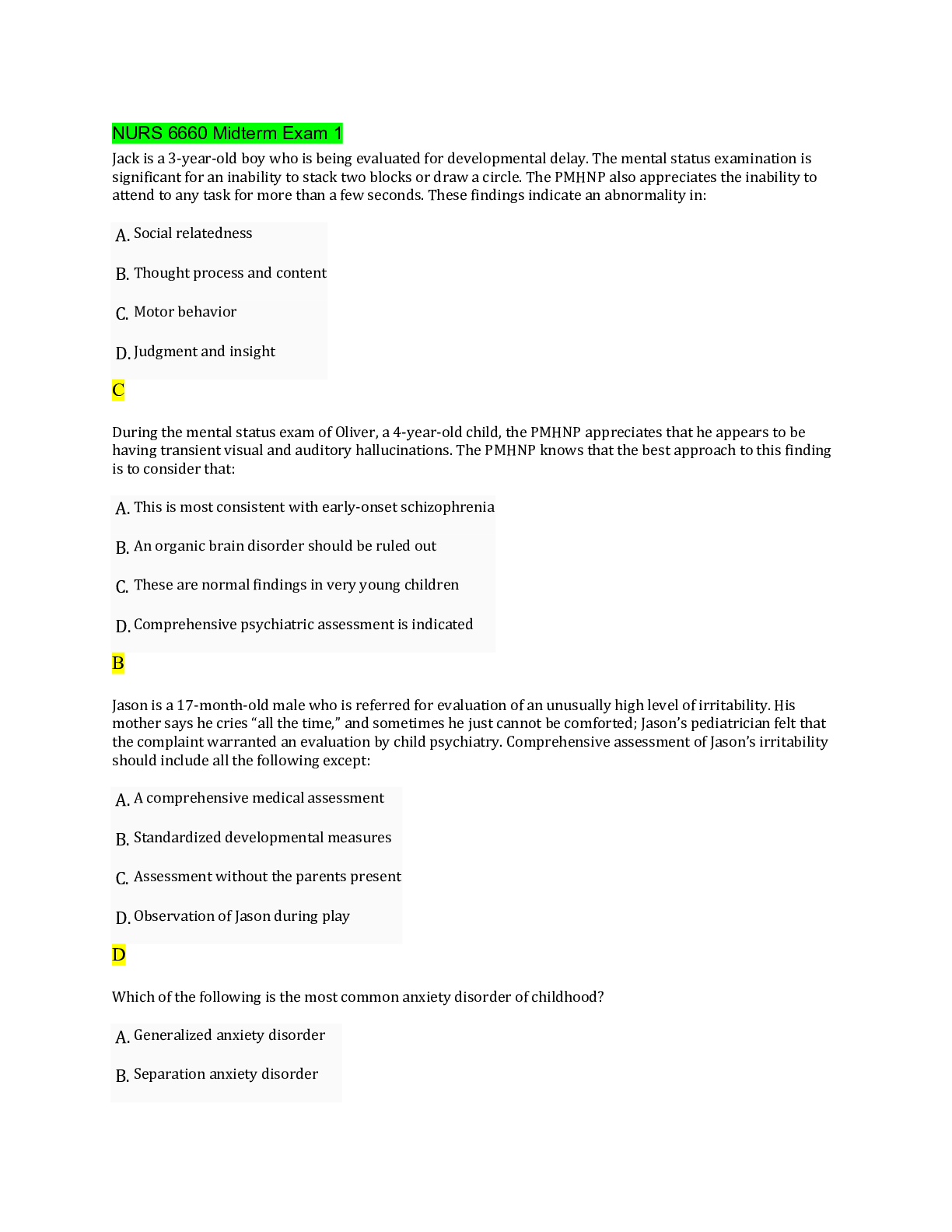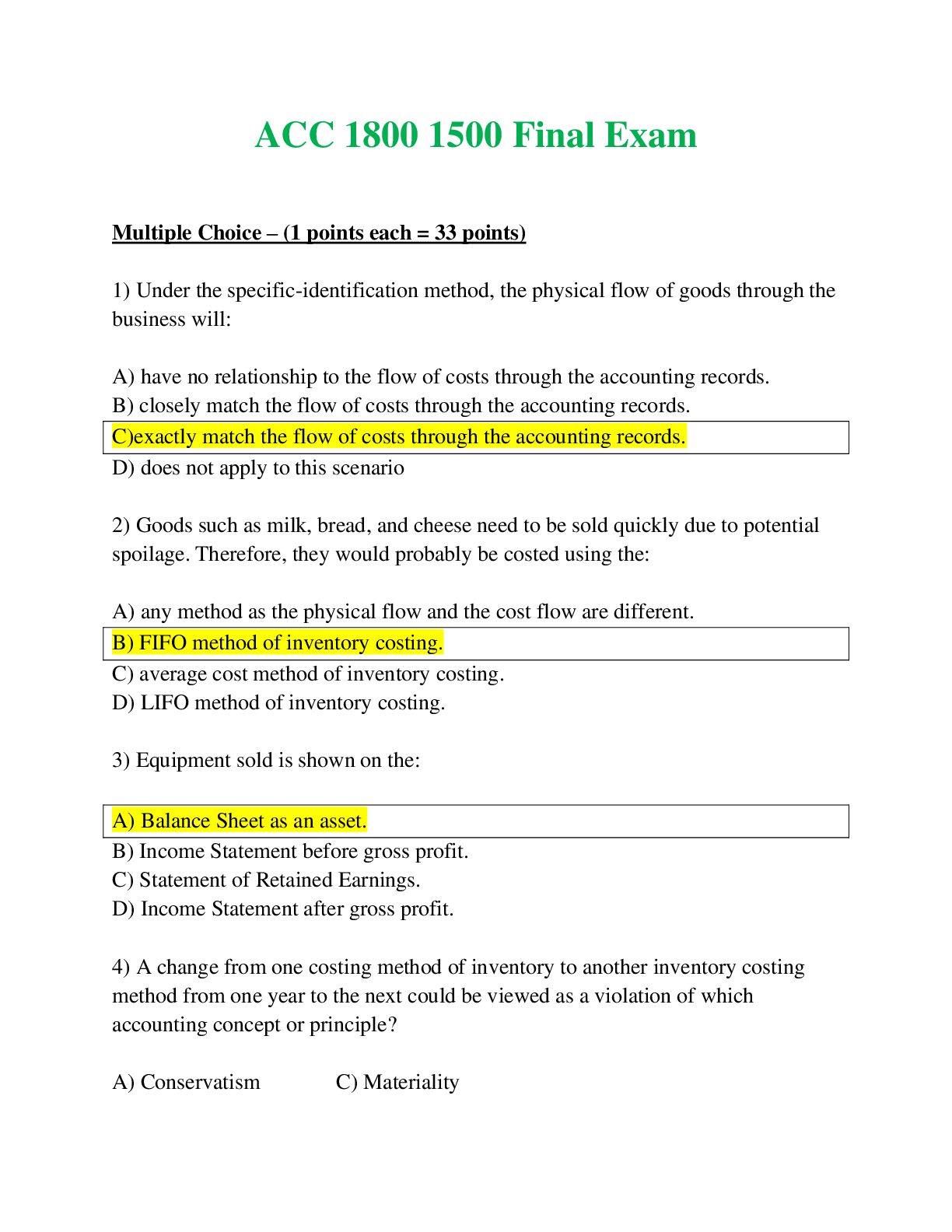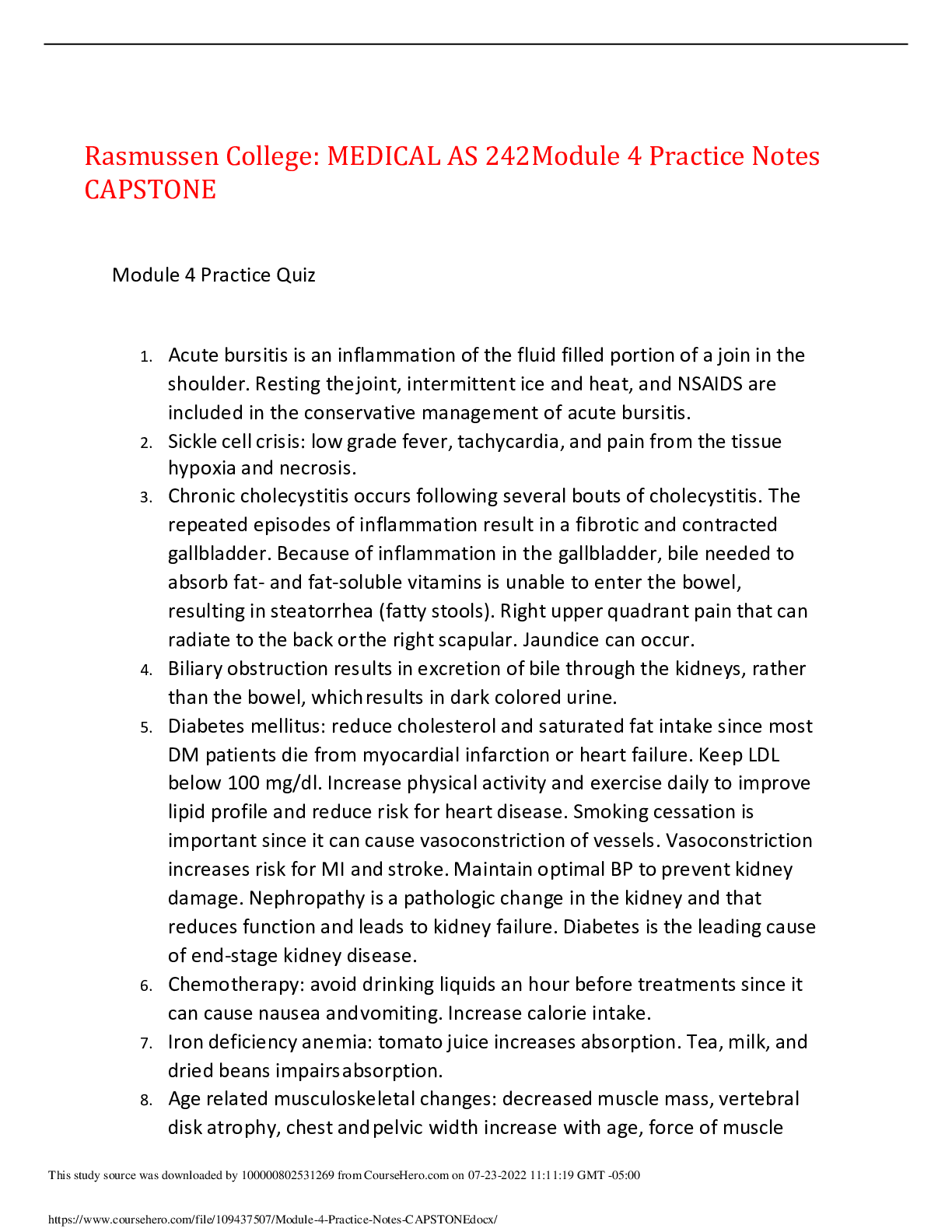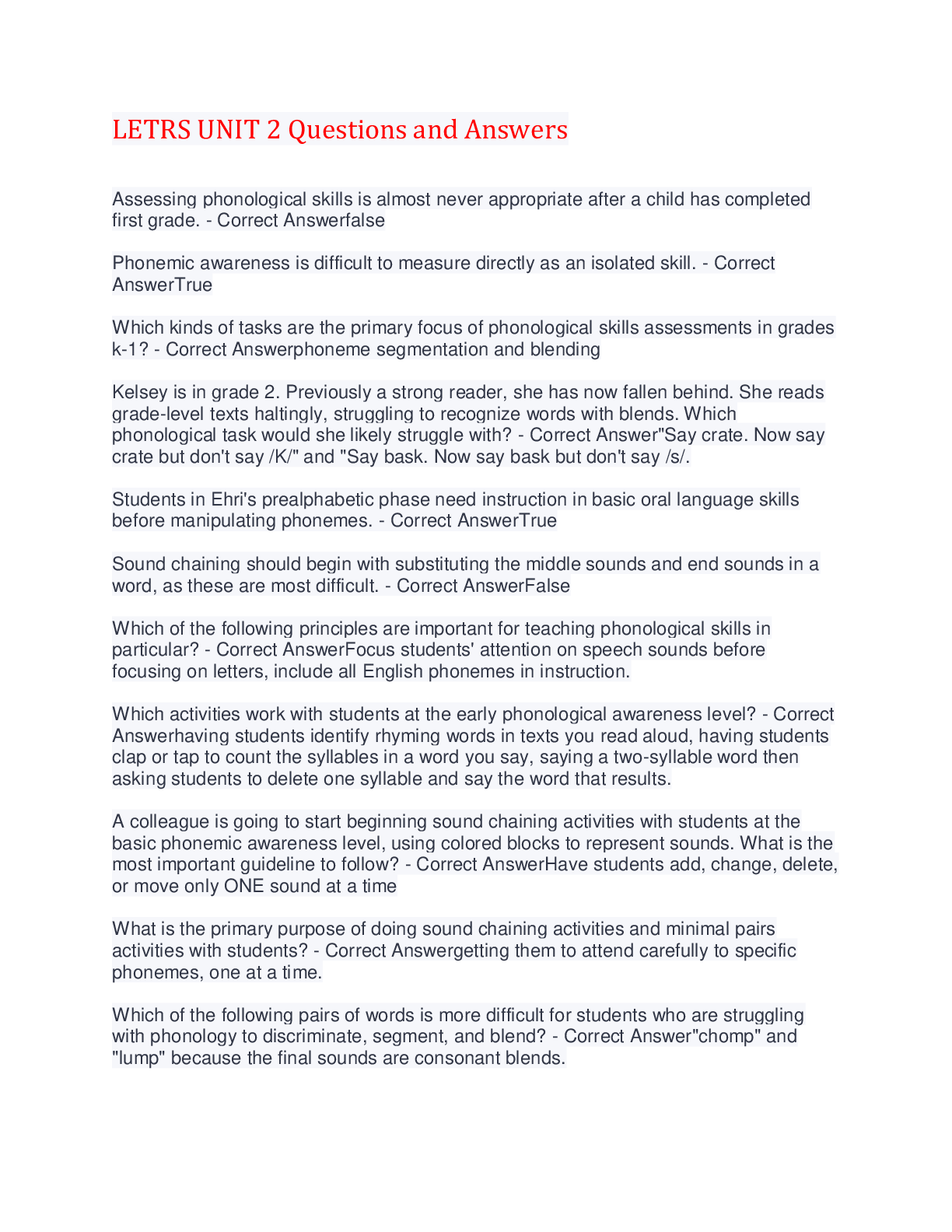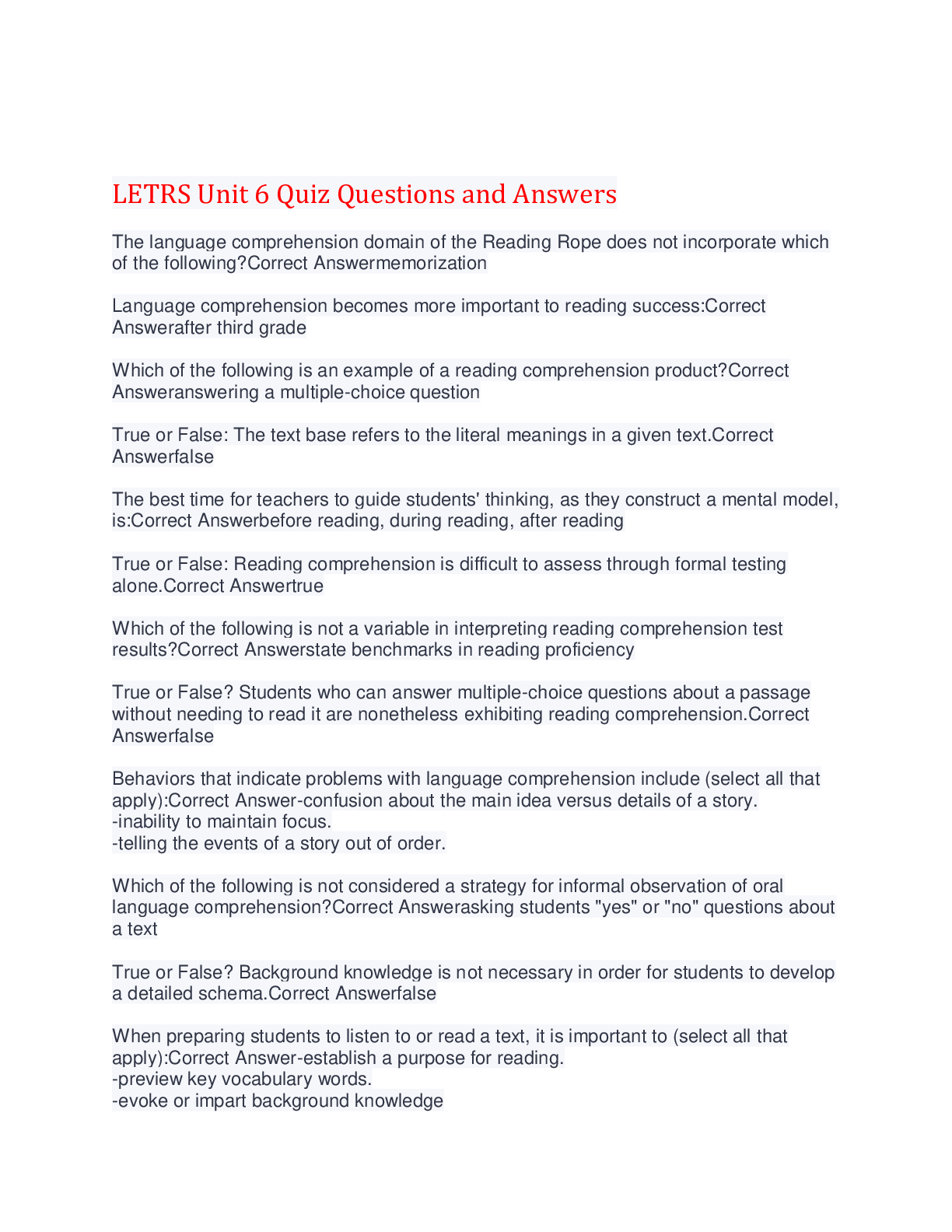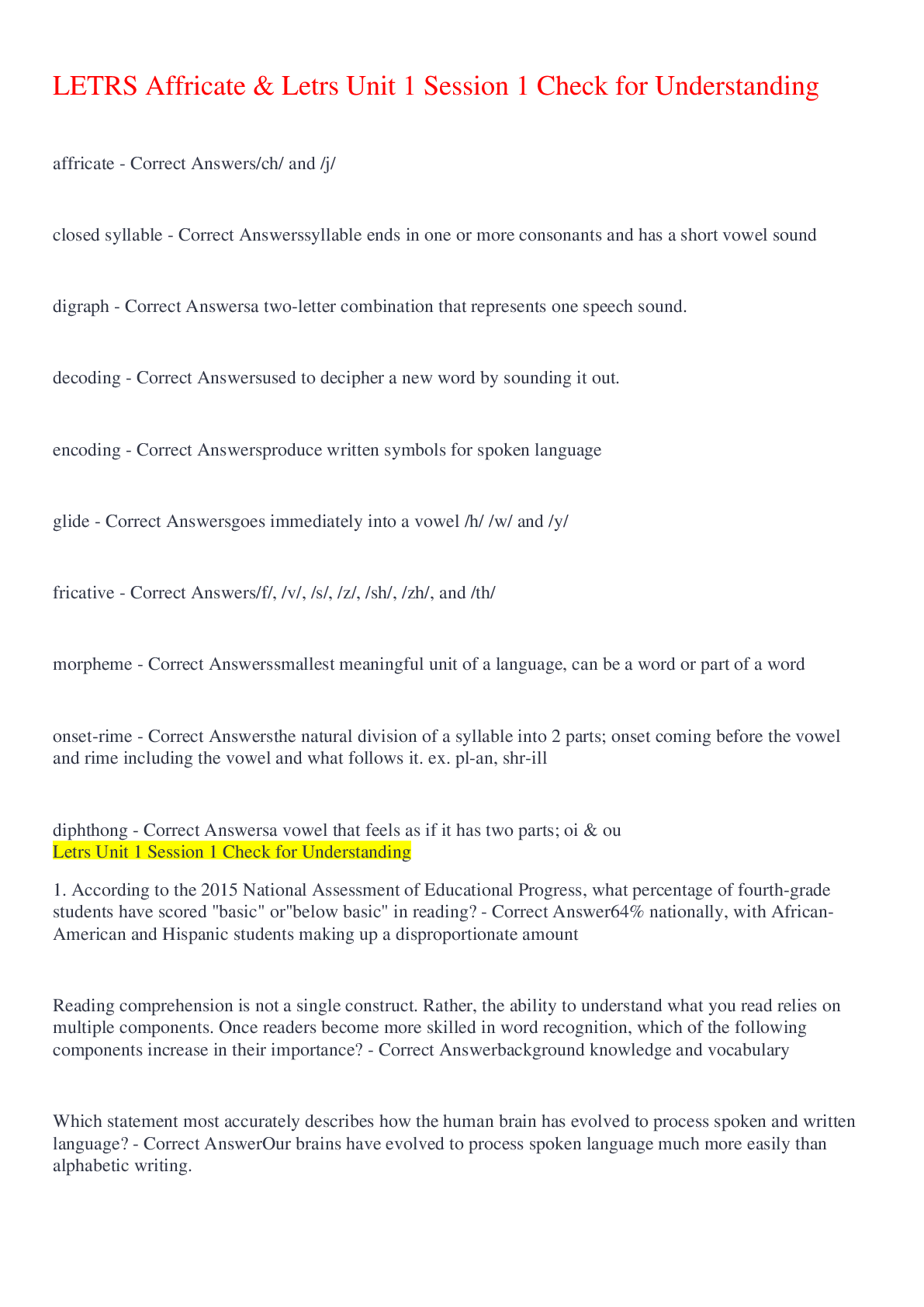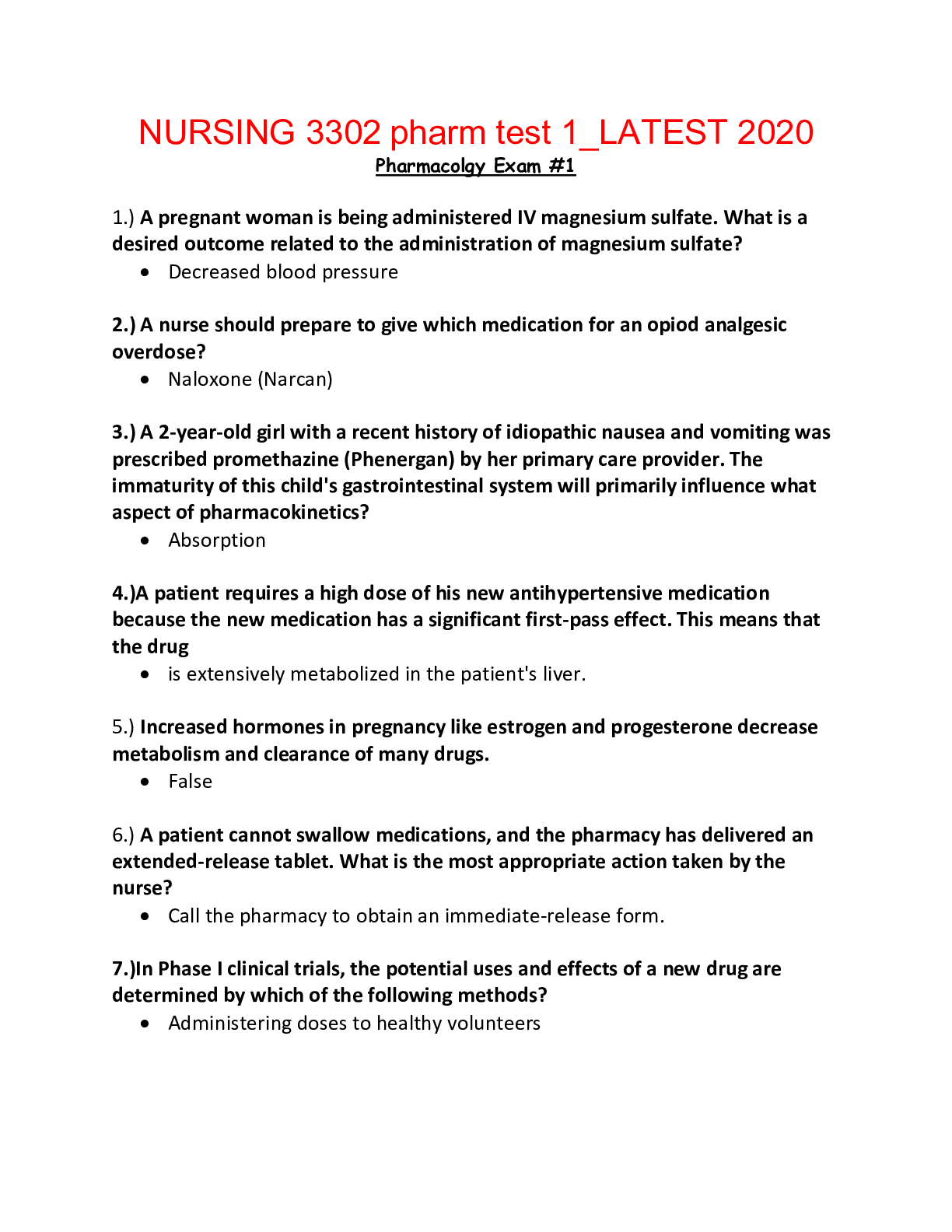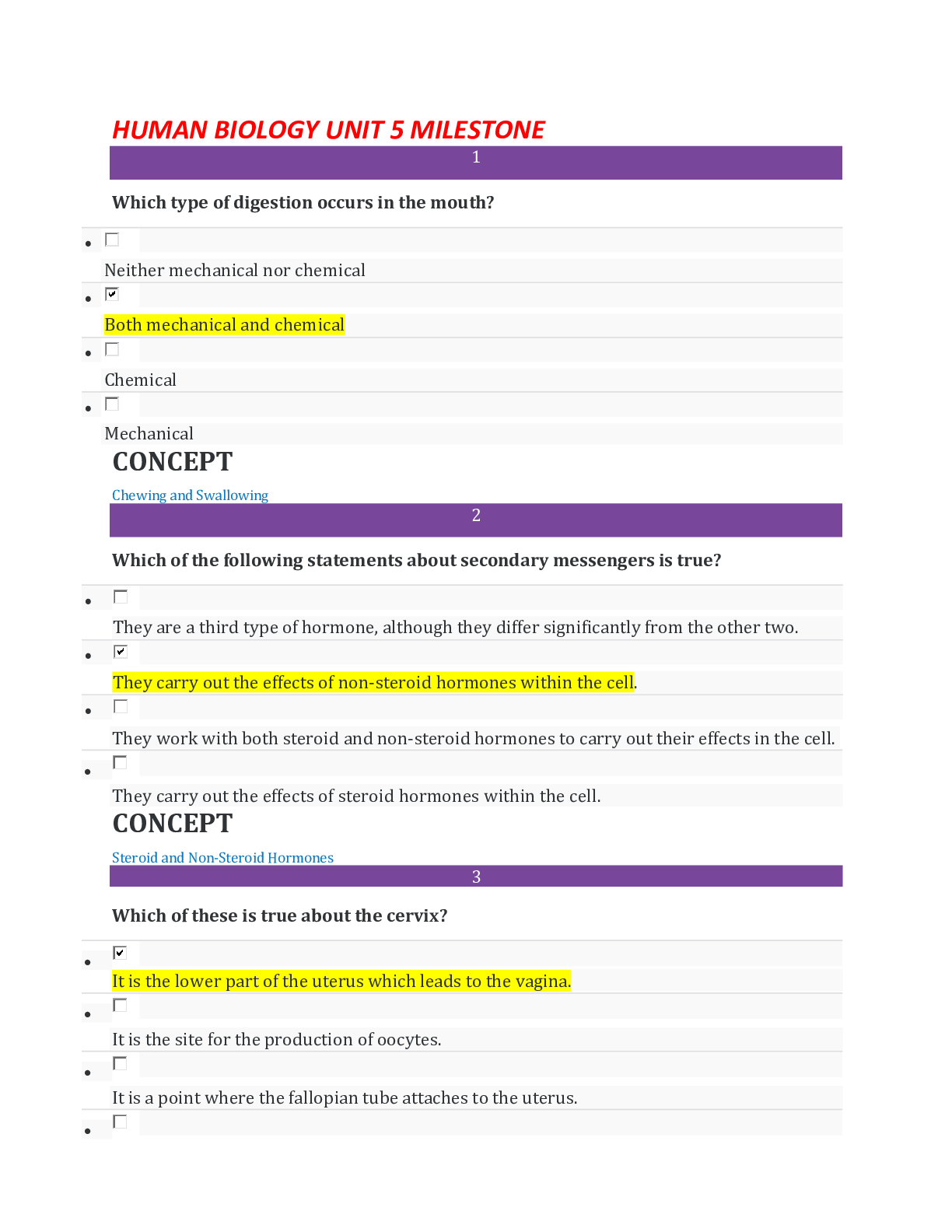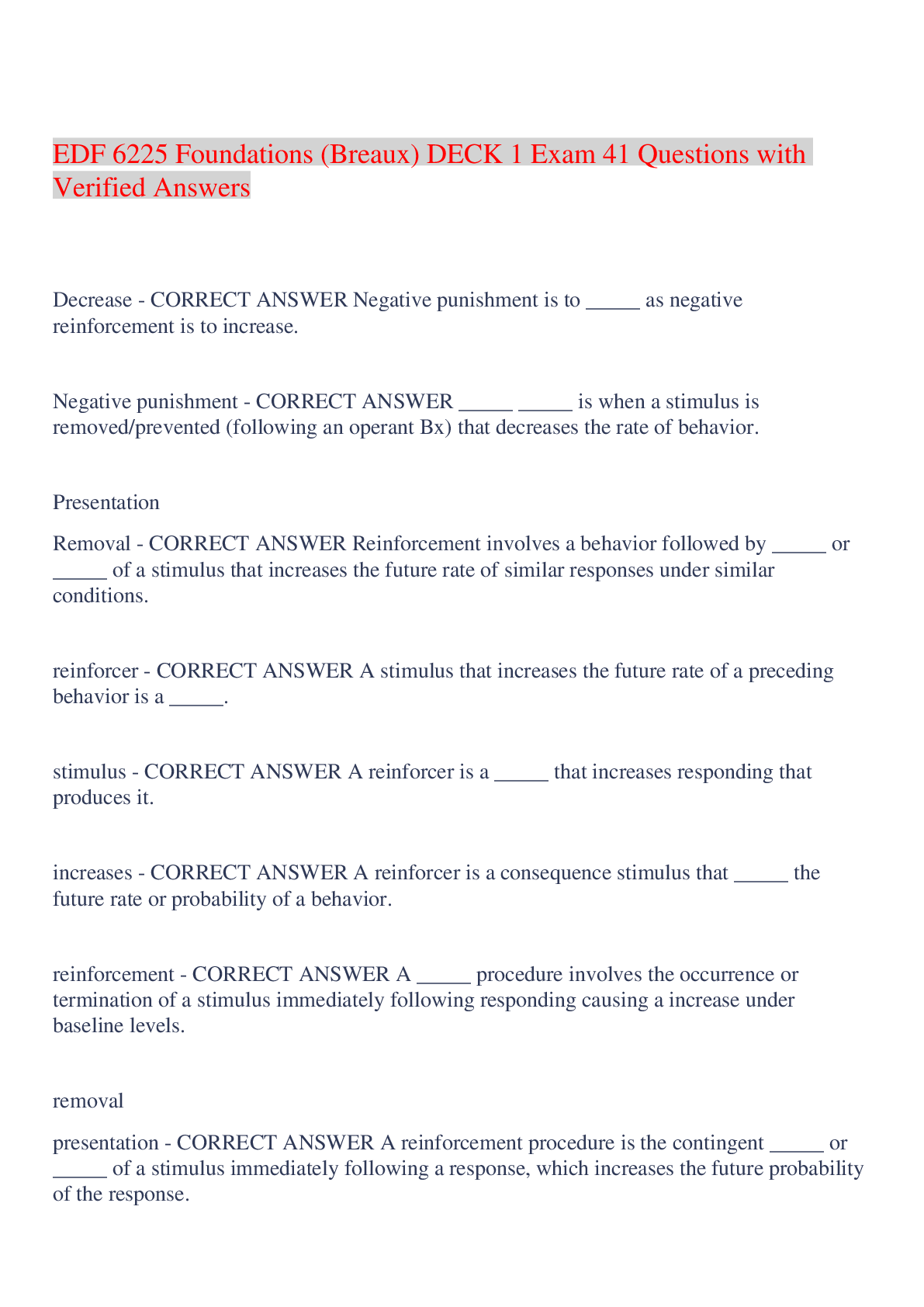NUR 307 Pharm Final Exam 1 (120 Q&A),100% CORRECT
Document Content and Description Below
The nurse is reviewing herbal therapies. Which is a common use of the herb feverfew? 2. A patient is to receive acetylcysteine (Mucomyst) as part of the treatment for an acetaminophen (Tylenol) ov... erdose. Which action by the nurse is appropriate when giving this medication? 3. A patient is receiving gabapentin (Neurontin), an anticonvulsant, but has no history of seizures. The nurse expects that the patient is receiving this drug for which condition? 4. The nurse is assessing a patient who has been admitted to the emergency department for a possible opioid overdose. Which assessment finding is characteristic of an opioid drug overdose? 5. The drug nalbuphine (Nubain) is an agonist-antagonist (partial agonist). The nurse understands that which is 6.The nurse is assessing a patient for contraindications to drug therapy with acetaminophen (Tylenol). Which patient should not receive acetaminophen? 7. A patient arrives at the urgent care center complaining of leg pain after a fall when rock climbing. The x-rays show no broken bones, but he has a large bruise on his thigh. The patient says he drives a truck and does not want to take anything strong because he needs to stay awake. Which statement by the nurse is most appropriate? 8. A patient is suffering from tendonitis of the knee. The nurse is reviewing the patient’s medication administration record and recognizes that which adjuvant medication is most appropriate for this type of pain? 9.During a fishing trip, a patient pierced his finger with a large fishhook. He is now in the emergency department to have it removed. The nurse anticipates that which type of anesthesia will be used for this procedure? 10.While monitoring a patient who had surgery under general anesthesia 2 hours ago, the nurse notes a sudden elevation in body temperature. This finding may be an indication of which problem? 11.When assessing patients in the preoperative area, the nurse knows that which patient is at a higher risk for an altered response to anesthesia? 12. A patient is undergoing abdominal surgery and has been anesthetized for 3 hours. Which nursing diagnosis would be appropriate for this patient? 13.When administering a neuromuscular blocking drug, the nurse needs to remember which principle? 14. A patient is being prepared for an oral endoscopy, and the nurse anesthetist reminds him that he will be awake during the procedure but probably will not remember it. What type of anesthetic technique is used in this situation? 15. During the immediate postoperative period, the Post Anesthesia Care Unit nurse is assessing a patient who had hip surgery. The patient is experiencing tachycardia, tachypnea, and muscle rigidity, and his temperature is 103° F (39.4° C). The nurse will prepare for what immediate treatment? 16. A patient who has received some traumatic news is panicking and asks for some medication to help settle down. The nurse anticipates giving which drug that is most appropriate for this situation? 17. A patient has been taking phenobarbital for 2 weeks as part of his therapy for epilepsy. He tells the nurse that he feels tense and that “the least little thing” bothers him now. Which is the correct explanation for this problem? 18. Ramelteon (Rozerem) is prescribed for a patient with insomnia. The nurse checks the patient’s medical history, knowing that this medication is contraindicated in which disorder? 19. The nurse notes in the patient’s medication history that the patient is taking cyclobenzaprine (Flexeril). Based on this finding, the nurse interprets that the patient has which disorder? 20. A patient has experienced insomnia for months, and the physician has prescribed a medication to help with this problem. The nurse expects which drug to be used for long-term treatment of insomnia? 21. A patient tells the nurse that he likes to drink kava herbal tea to help him relax. Which statement by the patient indicates that additional teaching about this herbal product is needed? 22. A patient is receiving instructions regarding the use of caffeine. The nurse shares that caffeine should be used with caution if which of these conditions is present? 23. A patient who started taking orlistat (Xenical) 1 month ago calls the clinic to report some “embarrassing” adverse effects. She tells the nurse that she has had episodes of “not being able to control my bowel movements.” Which statement is true about this situation? 24. A 6-year-old boy has been started on an extended-release form of methylphenidate hydrochloride (Ritalin) for the treatment of attention deficit hyperactivity disorder (ADHD). During a follow-up visit, his mother tells the nurse that she has been giving the medication at bedtime so that it will be “in his system” when he goes to school the next morning. What is the nurse’s appropriate evaluation of the mother’s actions? 25. A 22-year-old nursing student has been taking NoDoz (caffeine) tablets for the past few weeks to “make it through” the end of the semester and exam week. She is in the university clinic today because she is “exhausted.” What nursing diagnosis may be appropriate for her? 26. A 10-year-old patient will be started on methylphenidate hydrochloride (Ritalin) therapy. The nurse will perform which essential baseline assessment before this drug is started? 27. When evaluating a patient who is taking orlistat (Xenical), which is an intended therapeutic effect? 28. The nurse is teaching a patient how to self-administer triptan injections for migraine headaches. Which statement by the patient indicates that he needs further teaching? 30. The nurse is reviewing the dosage schedule for several different antiepileptic drugs (AEDs). Which antiepileptic drug allows for once-a-day dosing? 31. The nurse has given medication instructions to a patient receiving phenytoin (Dilantin). Which statement by the patient indicates that the patient has an adequate understanding of the instructions? 32. When teaching a patient about taking a newly prescribed antiepileptic drug (AED) at home, the nurse will include which instruction? 33. A patient has a 9-year history of a seizure disorder that has been managed well with oral phenytoin (Dilantin) therapy. He is to be NPO (consume nothing by mouth) for surgery in the morning. What will the nurse do about his morning dose of phenytoin? 34. A patient is experiencing status epilepticus. The nurse prepares to give which drug of choice for the treatment of this condition? statusepilepticus is seizures that follow one another without recovery of consciousness b/w them 35.A patient is taking an alpha blocker as treatment for benign prostatic hyperplasia. The nurse will monitor for which potential drug effects? 36.which nursing diagnosis is appropriate for a patient who has just received a prescription for a new medication? 37.The nurse is assessing a newly admitted 83-year-old patient and determines that the patient is experiencing polypharmacy. Which statement most accurately illustrates polypharmacy? 38.The nurse is reviewing medication errors. Which situation is an example of a medication error? 39. The nurse is assessing the medication history of a patient with a new diagnosis of Parkinson's disease. Which condition is a concern for the patient, who will be taking tolcapone (Tasmar)? 40.A patient has a new order for a catechol-O-methyltransferase (COMT) inhibitor as part of treatment for Parkinson's disease. The nurse recognizes that an advantage of this drug class is that 41. The nurse is developing a care plan for a patient who is taking an anticholinergic drug. Which nursing diagnosis would be appropriate for this patient? 42. During discharge patient teaching the nurse reviews prescriptions with a patient. which statement is correct about refills for an analgesic that is classified as Schedule C-III? 43. While a patient is receiving drug therapy for Parkinson's disease, the nurse monitors for dyskinesia, which is manifested by - difficulty in performing voluntary movements 44. A patient is recovering from a minor automobile accident that occurred 1 week ago. He is taking cyclobenzaprine (Flexeril) for muscular pain and goes to physical therapy three times a week. Which nursing diagnosis would be appropriate for him? 45.A patient has been taking temazepam (Restoril) for intermittent insomnia. She calls the nurse to say that when she takes it, she sleeps well, but the next day she feels "so tired." Which explanation by the nurse is correct? 46. A patient wants to take a ginseng dietary supplement. The nurse instructs the patient to look for which potential adverse effect? 47. A patient is going home with a new prescription for the beta-blocker atenolol (Tenormin). The nurse will include which content when teaching the patient about this drug? 48. The nurse will plan to use the Z-track method of intramuscular (IM) injections for which situation? 49 When a patient is taking an anticholinergic such as bentropine (Cogentin) as part of the treatment for Parkinson disease, the nurse should include which information in the teaching plan? 50 A patient taking entacapone (Comtan) for the first time calls the clinic to report a dark discoloration of his urine. After listening to the patient, the nurse realizes that what is happening in this situation? 51 The nurse is screening a patient who will be taking a nonspecific/nonselective beta blocker. Which condition, if present, may cause serious problems if the patient takes this medication? 51 The nurse is reviewing facts about pharmacology for course. The term legend drug refers to which item? 52 A 60-year-old patient is on several new medications and expresses worry that she will forget to take her pills. Which action by the nurse would be most helpful in this situation? 53 A patient is on a low-dose dobutamine for heart failure. She had been feeling better but now has a sense of tightness in her chest, palpitations and a bit of anxiety. Her heart rate is up to 110 per minute, and her blood pressure is 150/98 mm Hg (increased from the previos reading of 86 per minute and 120/80 mm Hg). What is the nurse is immediate concern for this patient? 54 The patient is reviewing two different drugs. At current dosage and dosage forms, both drugs are absorbed into the circulation in identical amounts. Which term is used to identify this principle? 55 The nurse is reviewing pharmacology terms of a group of newly graduated nurses. Which sentence defines a drug’s half-life? 56 Chlorpromazine (Thoraine) is prescribed for a patient, and the nurse provides instructions to the patient about the medication. The nurse includes which information? 57 The nurse has an order to administer an intramuscular (IM) immunization to a 2-month-old child. Which site is considered the best choice for this injection? 58 During initial rounds, the nurse notes that a dobutamine infusion has extravasted into the forearm of a patient. After stopping the infusion, the nurse follows standing orders and immediaty injects phentolamine (Regitine) subcutaneously in a circular fashion around the extravastion site. What is the mechanism of action of the phentolamine in this situation? 59 The nurse is assigned to patient who is newly diagnosed with type 1 diabetes mellitus. Which statement best illustrates an outcome criterion for this patient? 60 A patient has been taking selegiline (Eldepryl), 20mg/day for 1 month. Today, during his office visit, he tells the nurse that he forgot and had a beer with dinner last evening, and felt awful. What did the patient most likely experience? 61 A patient is undergoing major surgery and asks the nurse about a living will. He states, if don’t want anybody else making decisions for me. And I don’t want to prolong my life. The patient is demonstrating which ethical term? 62 When administering drugs, the nurse remembers that the duration of action of a drug is defined as which of these? 63 When discussing dosage calculation for pediatric patients with clinical pharmacist, the nurse notes that which type of dosage calculation is used most commonly in pediatric calculations? 64 .when giving buccal medication to a patient .which action by the nurse is appropriate? 65. A 38-year-old man has come into the urgent care center with severe hip pain after falling from a ladder at work. He says he has taken several pain pills over the past few hours but cannot remember how many he has taken. He hands the nurse an empty bottle of acetaminophen (Tylenol). The nurse is aware that the most serious toxic effect of acute acetaminophen overdose is which condition? 66 During a teaching session about self-monitoring while taking a beta blocker at home, the nurse has taught the patient to take his apical pulse daily for 1 minute. If the pulse rate decrease to less than 60 beats/min, the nurse will instruct the patient to: 67 The nurse is reviewing the mechanism of action of cholingic drugs. The undesired effects of cholinergic drugs come from the stimulation of which receptors? 68 A patient is being treated for ethanol alcohol abuse in a rehabilitation center. The nurse will include which information when teaching him about disulfram (Antabuse) therapy? 69 During a period of time when the computerized medication order system was down, the presciber wrote admission orders, and the nurse is transcribing them. The nurse is having difficulty transcribing one order because of the presciber’shand writing. Which is the best action for the nurse to take at this time? 70 A patient is taking flurazepam (dalmane) three to four nights a week for sleeplessness. She is concerned that she cannot get to sleep without taking the medication. What nonpharmacologic measure should the nurse suggest to promote sleep for this patient? 71 The nurse is monitoring a patient who is in the 26th week of pregnancy and has developed gestational diabetes and pneumonia. She is given medications that pose a possible fetal risk, but the potential benefits may warrant the use of the medications in her situation. The nurse recognizes that these medications are in which U.S Food and Drug administration pregnancy safety category? 72 During therapy with a beta blocker, the patient notices that she has swollen feet, has gained 3 pounds within 2 days, feels short of breath even when walking around the house, and has been dizzy. The nurse suspects that which of these is occurring? 73 A patient is experiencing diastolic heart failure. The nurse expects which beta blocker to be ordered for this patient? 74 A patient is receiving a dose of endrophonium (tensilon). The nurse recognizes that this drug is given to determine the diagnosis of which disease? 75 A patient with a new prescription for a diuretic has just reviewed with the nurse how to include more potassium in her diet. This reflects learning in which domain? 76 When the nurse considers the timing of a drug dose, which factor is appropriate to consider when deciding when to give a drug? 77 The patient is experiencing chest pain and needs to take a sublingual form of nitroglycerin. Where does the nurse instruct the patient to place the tablet? 78 Drug transfer to the fetus is more likely during the last trimester of pregnancy for which reason? 79 Before beginning a patients therapy with selective serotonin reuptake (SSRI) antidepressants, the nurse will assess for concurrent use of which medications or medication class? 80 A 29-year-old male patient is admitted to the intensive care unit with the following symptoms: restlessness, hyperactive reflexes, talkativeness, confusion and periods of panic and euphoria, tachycardia, and fever. The nurse suspects that he may be experiencing the effects of taking which substance? 81 The nurse is reviewing medications used for depression. Which of these statements is a reason that selective serotonin reuptake inhibitors (SSRIs) are more widely prescribed today than tricyclic antidepressants? 82 A patient has been taking haloperidol (Haldol) for 3 months for a psychotic disorder, and the nurse is concerned about the development of extrapyramidal symptoms. The nurse will monitor the patient closely for which effects? 83 the nurse is assessing an elderly Hispanic woman who is being treated for hypotension. During the assessment, what is important for the nurse to remember about cultural aspects? 84 the nurse is asking a patient about his family history as part of an assessment. Which component is in an effective family history? 85 the medication order reads, Give ondansetron (Zofran) 4mg, 30 minutes before beginning chemotherapy to prevent nausea. The nurse notes that the route is missing from the order. What is the nurse’s best action? 86 the nurse is reviewing the applications of gene therapy. Which drug is manufactured as a result of indirect gene therapy? 87 a patient says he prefers to chew rather than swallow his pills. One of the pills has the abbreviation SR behind the name of the medication. The nurse needs to remember which correct instruction regarding how to give this medication? 88 a patient has been treated for lung cancer for 3 years. Over the past few months, the patient has noticed that the opioid analgesic is not helping as much as it had previously and more medication is need to relief the same pain relief. The nurse is aware that this patient is experiencing which of these? 89 a patient has been given a prescription for levodopa-carbidopa (sinemet) for her newly diagnosed Parkinsons disease. She asks the nurse, why are there two drugs in this pill? The nurse best response reflects which fact? 90 a patient was diagnosed with pancreatic cancer last month, and has complained of a dull ache in the abdomen for the past 4 months. This pain has been graudully increasing, and the pain relievers taken at home are no longer effective. What type of pain is the patient experiencing? 91 When adding medications to a bag of intravenous (IV) fluid, the nurse will use which method to mix the solution? 92 the nurse is administering medications to the patient who is in renal failure resulting from end-stage renal disease. The nurse is aware that patients with kidney failure would most likely have problems with which pharmacokinetic phase? 93 When reviewing the various schedules of controlled drugs, the nurse knows that which description correctly describes schedule II drugs? 94 the patient is to receive oral guaifenesin (mucinex) twice a day. Today, the nurse was busy and gave the medication 2 hours after the scheduled dose was due. What type of problem does this represent? 95 the nurse is preparing to give an injection to a 4-year-old child. Which intervention is age appropriate for this child? 96 When administering medication by IV bolus (push), the nurse will occlude the IV line by which method? 97 the nurse is about to give a rectal suppository to a patient. Which technique would facilitate the administration and absorption of the rectal suppository? 98 a patient who has had abdominal surgery has been discharged on a cholinergic drug to assist in increasing gastrointestinal peristalsis. The nurse will teach this patient to look for which therapeutic effect? 99 A 58-year-old man has had a myocardial infraction(MI), has begun rehabilitation, and is ready for discharge. He is given a prescription for metoprolol (Lopressor) and becomes upset after reading the patient education pamphlet. I don’t have high blood pressure why did my doctor give me this medicine? Which explanation by the nurse is correct? 100 The nurse is administering an IV push medication through an IV lock. After injecting the medication, which action will be taken next? 101 A patient is to receive a penicillin intramuscular (IM) injection in the Ventrogluteal site. The nurse will use which angle for the needle insertion? 102 the nurse recognizes that it is not uncommon for an elderly patient to experience a reduction in the stomach’s ability to produce hydrochloric acid. This change may result in which effect? 103 The teaching for a patient who is taking tamulsin (Flomax) to reduce urinary obstruction due to benign prostatic hyperplasia will include which of these? 104 the nurse is trying to give a liquid medication to a 2 1/2-year-old child and notes that the medication has a strong taste. Which technique is best way for the nurse to give the medication to this child? 105 A patient will be discharged with a 1 week supply of an opioid analgesic for pain management after abdominal surgery. the nurse will include which information in the teaching plan? 106 A 57-year-old woman being treated for end-stage breast cancer has been using a transdermal opioid analgesic as part of the management of pain. Lately, she has been experiencing breakthrough pain. The nurse expects this type of pain to be managed by which of these interventions? 107 the nurse is reviewing a list of verbal medication orders. Which is the proper notation of the dose of the drug order? 108 For accurate medication administration to pediatric patients, the nurse must take into account which criteria? 109 The nurse working in a preoperative admitting unit administers an anticholinergic medication to a patient before surgery. What is the purpose of this drug in the preoperative setting? 110 When a patient is taking an adrenergic drug, the nurse expects to observe which effect? 111 The nurse is explaining the human genome project to colleagues. which of these is the main purpose of the human genome project? 112 When administering nasal spray, which instruction by the nurse is appropriate? 113 A factory worker has been admitted to the emergency department after an industrial accident involving organophosphate insecticides. The nurse will prepare to administer which drug? 114 A patient calls the clinic to speak to the nurse about taking an herbal product that contains ginkgo (Ginkgo biloba) to help my memory. He states that he has read much information about herbal product. Which statement by the patient indicates a need for further education? 115 When an adrenergic drug stimulates beta1-adrenergic receptors, the result is an increased force of contraction, which is known as what type of effect? 116 a patient has a prescription for oxybutynin (Ditropan), an anticholinergic drug. When reviewing the patient medical history, which condition, if present, would be considered a contraindication to therapy with this drug? 117 A patient has a new prescription for tamsulosin (Flomax) as treatment for benign prostatic hyperplasia. The nurse is checking his current medication list and will contact the prescriber regarding a potential interaction if the patient is also taking which drug? 118 The nurse is performing an assessment of a newly admitted patient. Which is an example of subjective data? 119 When giving medications, the nurse will use standard precautions, which include what action? 120 The nurse is reviewing a patient medication history and notes that the patient is taking the cholinergic blocker tolterodine (Detrol). Which is an indication for this medication? [Show More]
Last updated: 2 years ago
Preview 1 out of 16 pages
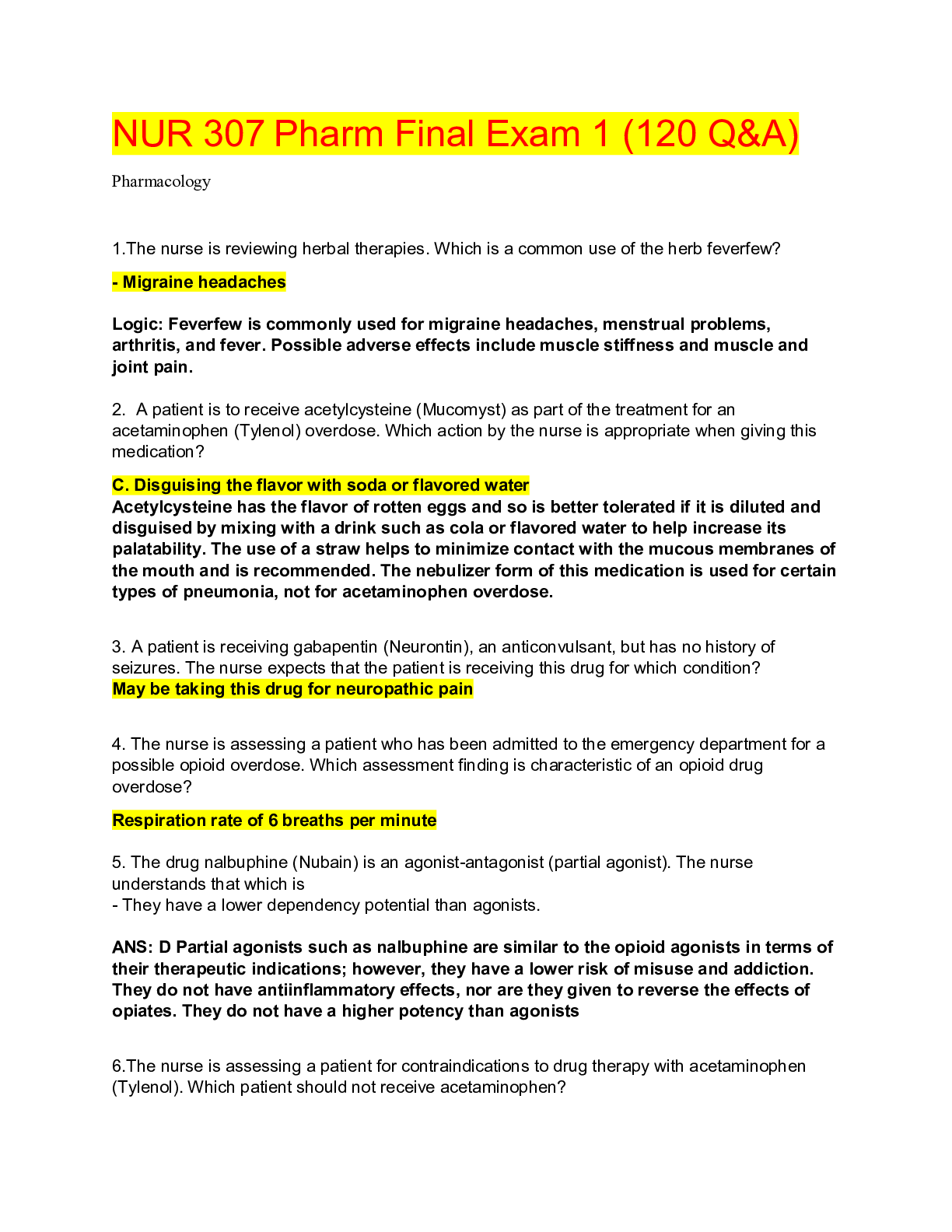
Buy this document to get the full access instantly
Instant Download Access after purchase
Buy NowInstant download
We Accept:

Reviews( 0 )
$18.00
Can't find what you want? Try our AI powered Search
Document information
Connected school, study & course
About the document
Uploaded On
Nov 29, 2020
Number of pages
16
Written in
Additional information
This document has been written for:
Uploaded
Nov 29, 2020
Downloads
0
Views
83


